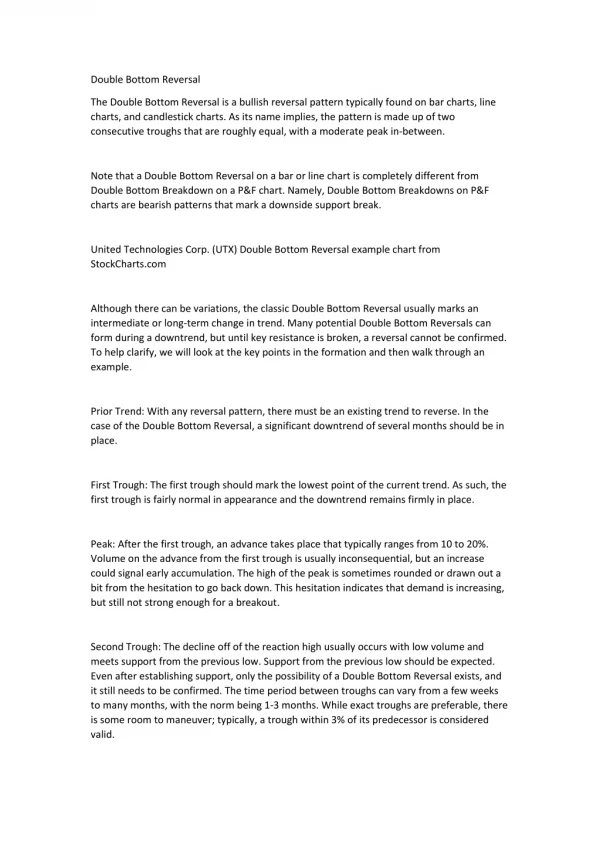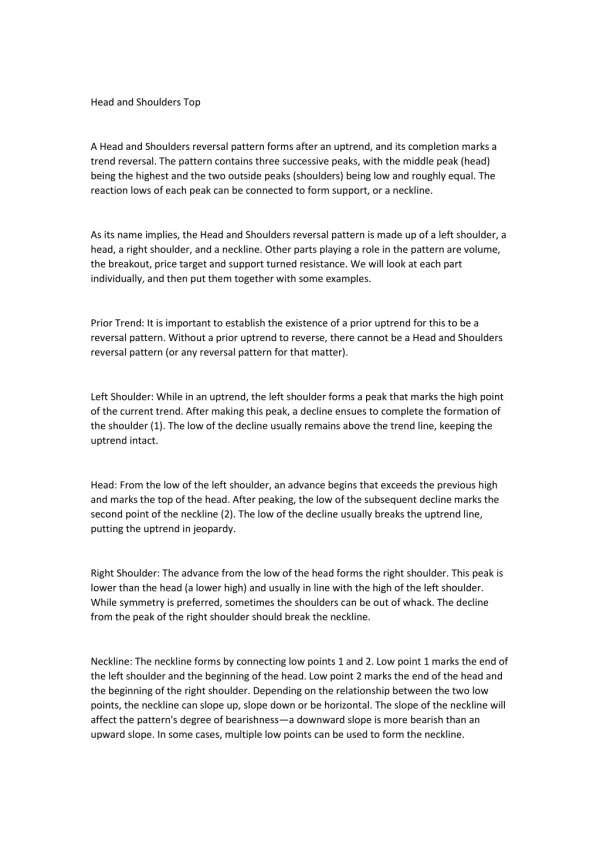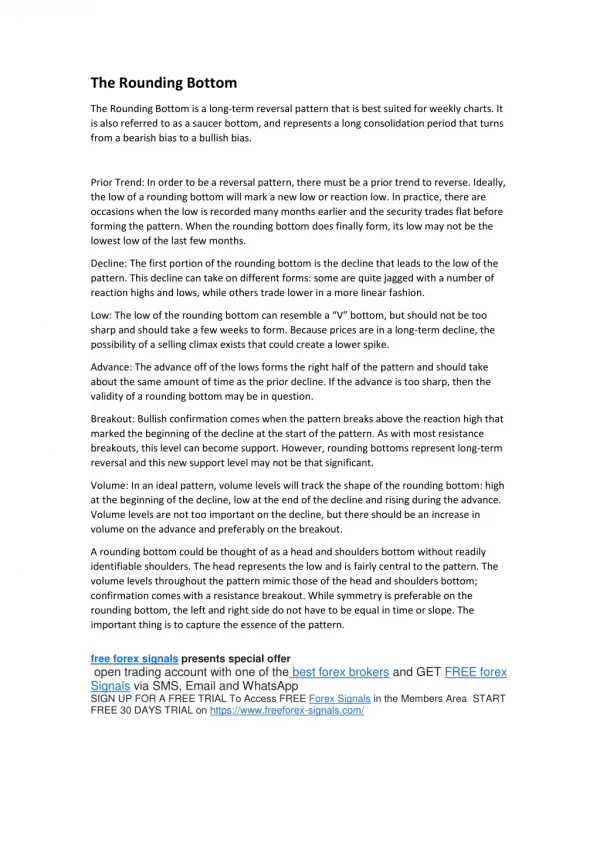Double Bottom Reversal
Double Bottom Reversal The Double Bottom Reversal is a bullish reversal pattern typically found on bar charts, line charts, and candlestick charts. As its name implies, the pattern is made up of two consecutive troughs that are roughly equal, with a moderate peak in-between. Note that a Double Bottom Reversal on a bar or line chart is completely different from Double Bottom Breakdown on a P&F chart. Namely, Double Bottom Breakdowns on P&F charts are bearish patterns that mark a downside support break. United Technologies Corp. (UTX) Double Bottom Reversal example chart from StockCharts.com Although there can be variations, the classic Double Bottom Reversal usually marks an intermediate or long-term change in trend. Many potential Double Bottom Reversals can form during a downtrend, but until key resistance is broken, a reversal cannot be confirmed. To help clarify, we will look at the key points in the formation and then walk through an example. Prior Trend: With any reversal pattern, there must be an existing trend to reverse. In the case of the Double Bottom Reversal, a significant downtrend of several months should be in place. First Trough: The first trough should mark the lowest point of the current trend. As such, the first trough is fairly normal in appearance and the downtrend remains firmly in place. Peak: After the first trough, an advance takes place that typically ranges from 10 to 20%. Volume on the advance from the first trough is usually inconsequential, but an increase could signal early accumulation. The high of the peak is sometimes rounded or drawn out a bit from the hesitation to go back down. This hesitation indicates that demand is increasing, but still not strong enough for a breakout. Second Trough: The decline off of the reaction high usually occurs with low volume and meets support from the previous low. Support from the previous low should be expected. Even after establishing support, only the possibility of a Double Bottom Reversal exists, and it still needs to be confirmed. The time period between troughs can vary from a few weeks to many months, with the norm being 1-3 months. While exact troughs are preferable, there is some room to maneuver; typically, a trough within 3% of its predecessor is considered valid. Advance From Trough: Volume is more important for the Double Bottom Reversal than the double top. There should be clear evidence that volume and buying pressure are accelerating during the advance off of the second trough. An accelerated ascent, perhaps marked with a gap or two, also indicates a potential change in sentiment. Resistance Break: Even after trading up to resistance, the double top and trend reversal are still not complete. Breaking resistance from the highest point between the troughs completes the Double Bottom Reversal. Like advances, these should occur with an increase in volume and/or an accelerated ascent. Resistance Turned Support: Broken resistance becomes potential support and there is sometimes a test of this newfound support level with the first correction. Such a test can offer a second chance to close a short position or initiate a long. Price Target: The distance from the resistance breakout to trough lows can be added on top of the resistance break to estimate a target. This would imply that the bigger the formation is, the larger the potential advance. It is important to remember that the Double Bottom Reversal is an intermediate to long-term reversal pattern that will not form in a few days. Even though formation in a few weeks is possible, it is preferable to have at least 4 weeks between lows. Bottoms usually take longer to form than tops; patience can often be a virtue. Give the pattern time to develop and look for the proper clues. The advance off of the first trough should be 10-20%. The second trough should form a low within 3% of the previous low and volume on the ensuing advance should increase. Volume indicators such as Chaikin Money Flow, OBV and Accumulation/Distribution can be used to look for signs of buying pressure. Just as with the double top, it is paramount to wait for the resistance breakout. The formation is not complete until the previous reaction high is taken out. free forex signals presents special offer open trading account with one of the best forex brokers and GET FREE forex Signals via SMS, Email and WhatsApp SIGN UP FOR A FREE TRIAL To Access FREE Forex Signals in the Members Area START FREE 30 DAYS TRIAL on https://www.freeforex-signals.com/ Double Bottom Reversal The Double Bottom Reversal is a bullish reversal pattern typically found on bar charts, line charts, and candlestick charts. As its name implies, the pattern is made up of two consecutive troughs that are roughly equal, with a moderate peak in-between. Note that a Double Bottom Reversal on a bar or line chart is completely different from Double Bottom Breakdown on a P&F chart. Namely, Double Bottom Breakdowns on P&F charts are bearish patterns that mark a downside support break. United Technologies Corp. (UTX) Double Bottom Reversal example chart from StockCharts.com Although there can be variations, the classic Double Bottom Reversal usually marks an intermediate or long-term change in trend. Many potential Double Bottom Reversals can form during a downtrend, but until key resistance is broken, a reversal cannot be confirmed. To help clarify, we will look at the key points in the formation and then walk through an example. Prior Trend: With any reversal pattern, there must be an existing trend to reverse. In the case of the Double Bottom Reversal, a significant downtrend of several months should be in place. First Trough: The first trough should mark the lowest point of the current trend. As such, the first trough is fairly normal in appearance and the downtrend remains firmly in place. Peak: After the first trough, an advance takes place that typically ranges from 10 to 20%. Volume on the advance from the first trough is usually inconsequential, but an increase could signal early accumulation. The high of the peak is sometimes rounded or drawn out a bit from the hesitation to go back down. This hesitation indicates that demand is increasing, but still not strong enough for a breakout. Second Trough: The decline off of the reaction high usually occurs with low volume and meets support from the previous low. Support from the previous low should be expected. Even after establishing support, only the possibility of a Double Bottom Reversal exists, and it still needs to be confirmed. The time period between troughs can vary from a few weeks to many months, with the norm being 1-3 months. While exact troughs are preferable, there is some room to maneuver; typically, a trough within 3% of its predecessor is considered valid. Advance From Trough: Volume is more important for the Double Bottom Reversal than the double top. There should be clear evidence that volume and buying pressure are accelerating during the advance off of the second trough. An accelerated ascent, perhaps marked with a gap or two, also indicates a potential change in sentiment. Resistance Break: Even after trading up to resistance, the double top and trend reversal are still not complete. Breaking resistance from the highest point between the troughs completes the Double Bottom Reversal. Like advances, these should occur with an increase in volume and/or an accelerated ascent. Resistance Turned Support: Broken resistance becomes potential support and there is sometimes a test of this newfound support level with the first correction. Such a test can offer a second chance to close a short position or initiate a long. Price Target: The distance from the resistance breakout to trough lows can be added on top of the resistance break to estimate a target. This would imply that the bigger the formation is, the larger the potential advance. It is important to remember that the Double Bottom Reversal is an intermediate to long-term reversal pattern that will not form in a few days. Even though formation in a few weeks is possible, it is preferable to have at least 4 weeks between lows. Bottoms usually take longer to form than tops; patience can often be a virtue. Give the pattern time to develop and look for the proper clues. The advance off of the first trough should be 10-20%. The second trough should form a low within 3% of the previous low and volume on the ensuing advance should increase. Volume indicators such as Chaikin Money Flow, OBV and Accumulation/Distribution can be used to look for signs of buying pressure. Just as with the double top, it is paramount to wait for the resistance breakout. The formation is not complete until the previous reaction high is taken out. free forex signals presents special offer open trading account with one of the best forex brokers and GET FREE forex Signals via SMS, Email and WhatsApp SIGN UP FOR A FREE TRIAL To Access FREE Forex Signals in the Members Area START FREE 30 DAYS TRIAL on https://www.freeforex-signals.com/
★
★
★
★
★
56 views • 3 slides





